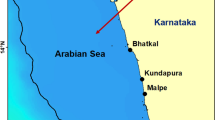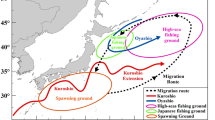Abstract
Atmospheric, hydrographic and fishery biological factors indicated that the abnormal northward shift in the distribution of Pacific saury might be the result of a strong flux of warm water into the Japan/East Sea in the late 1970s. Recruitment failure of saury in the late 1970s was attributed to the limitation of the productive area for primary production caused by oligotrophic warm water, and to mismatch of the time of the spring outburst with the earlier arrival of saury to the feeding ground. Comparison of monthly upper mixed layer depth (MLD) and critical depth supported the possibility of the mismatch phenomenon. However, an appropriate management scheme should be implemented to prevent recruitment overfishing for the stock when any sign of ocean climate changes is detected.
Similar content being viewed by others
References
Apanovich, S. I. (1962): New objects in saury fisheries. Ryb. Khoz, 38(1), 9–13 (in Russian).
Bathen, K. H. (1972): On the seasonal changes in the depth of the mixed layer in the North Pacific Ocean. J. Geophys. Res., 77(36), 7138–7150.
Baytalyuk, A. (2000): Distribution and stock of saury (Colorabis saira) in the northwestern part of the Japan Sea. p. 29–30. In Extended abstract. Science Board Symposium, 9th PICES Annual Meeting, Hakodate, Japan.
Chiba, S. and T. Saino (2002): Interdecadal changes in the upper water column environment and spring diatom community structure in the Japan Sea: an early summer hypothesis. Mar. Ecol. Prog. Ser., 231, 23–35.
Choe, C. Y. (1986): Effects of oceanographic conditions in spring-summer on the fishing ground formation of trout and sardine in the northern East Sea. East Sea Fish. Res. Inst., Bull. Fish. Sci. and Tech., 1, 3–17 (in Korean).
Cushing, D. H. (1989): A difference in structure between ecosystem in strongly stratified waters and in those that are only weakly stratified. J. Plankton Res., 11, 1–13.
Deser, C., M. A. Alexander and M. S. Timlin (1996): Upper ocean thermal variations in the North Pacific during 1970-1991. J. Climate, 9, 1840–1855.
Fujiwara, I. (1981): Oceanographic conditions in the East China Sea. Marine Science Monthly, 13(4), 264–270 (in Japanese).
Fukataki, H. (1959): Occurrence and distribution of eggs and larvae of the saury in the Tsushima Current region. Bull. Jpn. Sea Reg. Fish. Res. Lab., 7, 17–42 (in Japanese).
Fukataki, H. (1963): The growth stage and racial problem of the saury occurring in the Japan Sea. Reports of the Cooperative Investigations on the Saury in the Japan Sea for 1962, 117–132 (in Japanese).
Fukataki, H. (1966): Distribution, migration and population density of the saury occurring in the Japan Sea. Reports of the Cooperative Investigations on the Saury in the Japan Sea for 1963 and 1964, 123–134 (in Japanese).
Gong, Y. (1984): Distribution and movements of Pacific saury, Cololabis saira (Brevoort), in relation to oceanographic conditions in waters off Korea. Bull. Fish. Res. Dev. Agency, 33, 59–172.
Gong, Y. and Y. Q. Kang (1986): Sea surface temperature anomalies off the southeastern coast of Korea. Bull. Fish. Res. Dev. Agency, 37, 1–9.
Gong, Y. and H. J. Lie (1984): Distribution of thermal fronts in the South-East Sea of Korea (Southern Japan Sea). Min. Sci. and Tech. Korea, BSPE 00055-86-7B, 215 pp. (in Korean).
Gong, Y. and M. Y. Oh (1977): Oceanographic Environments and Fisheries Resources off the East Coast of Korea. National Federation of Fisheries Cooperatives, 633 pp.
Gong, Y. and S. J. Son (1982): A study of oceanic thermal fronts in the southwestern Japan Sea. Bull. Fish. Res. Dev. Agency, 28, 25–54 (in Korean).
Gong, Y., T. Hirano and C. I. Zhang (1983): On the migration of Pacific saury in relation to oceanographic conditions off Korean. Bull. Japan. Soc. Fish. Oceanogr., 44, 51–75.
Gong, Y., T. Hirano and C. I. Zhang (1985): A study on environmental conditions for Pacific saury in Korean waters. Bull. Japan. Soc. Fish. Oceanogr., 47-48, 36–58.
Han, H. S. and Y. Gong (1970): Relation between oceanographical conditions and catch of saury in the Eastern Sea of Korea. p. 585–592. In The Kuroshio. A Symposium on the Japan Current, ed. by J. C. Marr, East-West Center Press, Honolulu.
Hanawa, K. (1993): Long-term variation of the oceanic condition and its relation to the atmospheric general circulation. Umi to Sora, 68, 167–180.
Hanawa, K. (1995): Southward penetration of the Oyashio water system and the wintertime condition of midlatitude westerlies over the North Pacific. Bull. Hokkaido Natl. Fish. Res. Inst., 59, 103–120.
Hatanaka, M. and K. Sekino (1956): Spawning ground of the saury, Colorabis saira (Brevoort) in the Japan Sea. Tohoku Jour. Agr. Res., 7, 59–64.
Hirai, M. (1994): Evaluation of the effects of winter cooling on sea surface temperature in the spring around Tsushima Current regions. Bull. Japan Sea Natl. Fish. Inst., 44, 1–17 (in Japanese).
Inoue, N. (1981): Progress review on the hydrographic conditions in the East China Sea and Tsushima Warm Current area. Organisms of Koto Is., Comparison Iki Is. with Tsushima. Biol. Soc. Nagasaki, 29–72 (in Japanese).
Jo, M. K. (1977): A study on the distribution of eggs and larvae of saury in the Korean waters. Bull. Fish. Res. Dev. Agency, 16, 87–99 (in Korean).
Kawabe, M. (1995): Variations of current path, velocity, and volume transport of the Kuroshio in relation with the large meander. J. Phys. Oceanogr., 25, 3103–3117.
Kawasaki, T. (1994): A decade of the regime shift of small pelagics—from the FAO expert Consultation (1983) to the PICES (1994). Bull. Japan. Soc. Fish. Oceanogr., 58, 321–333 (in Japanese).
Kim, S. W. and Y. Isoda (1998): Interannual variations of the surface mixed layer in the Tsushima Current Region. Umi to Sora, 74, 11–22 (in Japanese).
Kim, S., S. Kang and D. Kang (1998): Effects of climate change in Korean waters. p. 69–81. In Proc. 1st Workshop on Climate Changes and Fisheries Resources, ed. by C. I. Zhang, S. Kim and J. O. Oh (in Korean).
Kim, Y. M. and Y. J. Park (1981): A study on the growth of saury, Cololabis saira (BREVOORT), based on the length composition in the Korean waters. Bull. Fish. Res. Dev. Agency, 27, 59–70 (in Korean).
Klyashtorin, L. B. (1998): Long-term climate change and main commercial fish production in the Atlantic and Pacific. Fish. Res., 37, 115–125.
Kotova, L. I. (1958): O biologii razmnozheniya sairy Yaponskom more (The biology of reproduction of saury in the Sea of Japan). Ryb. Khoz., 34(10), 6–11 (translated by Natl. Mar. Fish. Serv., Foreign Fish., Washington, D.C.).
Lee, J. W. (1986): Water temperature controlling fishing conditions of pollock in the East Sea. East Sea Fish. Res. Inst., Bull. Fish. Sci. and Tech., 1, 17–24 (in Korean).
Lim, J. Y., M. K. Jo and M. J. Lee (1970): The occurrence and distribution of the fish eggs and larvae in the Korean adjacent sea. Reports of Fisheries Resources, Fisheries Research and Development Agency, 8, 7–29 (in Korean).
Maizuru Marine Observatory, Maritime Meteorology Division (1972): Marine meteorological study of the Japan Sea. Tech. Rept. Japan Meteor. Agency, 80, 116 pp. (in Japanese).
Mantua, N. J., S. R. Hare, Y. Zhang, J. M. Wallace and R. C. Francis (1997): A Pacific interdecadal climate oscillation with impacts on salmon production. Bull. Amer. Meteor. Soc., 78, 1069–1079.
Miller, A. J. and N. Schneider (1998): Interpreting the observed patterns of Pacific Ocean decadal variation. p. 19–27. In Proceedings of the 10th ‘Aha Huliko’ a Hawaiian Winter Workshop on Biotic Impacts of Extratropical Climate Variability in the Pacific, January 26–29, 1998, ed. by G. Holloway, P. Muller and D. Henderson, NOAA Award No. NA 67 R J0154, SOEST Special Publication.
Minami, H., S. Kawabe, N. Nagai and J. Jifuka (1999): Long-term variability of oceanic conditions along the PM line in the Japan Sea. Sokko Jiho, 66, 63–80 (in Japanese).
Nagasaki Marine Meteorological Laboratory (1996): Reports of the Cooperative Investigations on Nagasaki Marine Meteorological Laboratory, 1996 (in Japanese).
Nagata, H. (1994): The relationship between chlorophyll-a and transparency in the southern Japan Sea. Bull. Japan Sea Natl. Fish. Res. Inst., 44, 39–47 (in Japanese).
Nagata, H., Y. Ogawa, M. Hirai and K. Hirakawa (1996): Geographical and seasonal changes of water transparency in the seas adjacent to Japan. Bull. Japan Sea Natl. Fish. Res. Inst., 46, 1–24 (in Japanese).
National Fisheries Research and Development Agency (NFRDA) (1962-1998): Annual Report of Oceanographic Observations for 1958-1997, Vol. 7-46.
Nishimura, S. (1969): The zoogeographical aspects of the Japan Sea. Part V. Publ. Seto. Mar. Biol. Lab., 17(2), 67–142.
Novikov, Yu. V. (1972): Relationship between the distribution of spawning groups of Pacific saury (Cololabis saira, BREVOORT) and the surface water in the Japan Sea and the Pacific Ocean. Vopr. Ikhtiol., 12(3), 572–576.
Novikov, Yu. V. (1979): Fisheries Biology of Pacific Sardine, Mackerel and Pacific Saury, TINRO (Japanese version by Translation Program of Science and Technology Cooperation of Japan and USSR), 69 pp.
Park, J. G. (1996): Long-term variation of phytoplankton biomass and photosynthesis characteristics accompanied of environmental change in the southern East Sea. Korea Doctoral dissertation, Graduate School. Seoul Nat’l. Univ., 173 pp. (in Korean).
Parsons, T. R. and R. J. LeBrasseur (1968): A discussion of some critical indices of primary and secondary production for large-scale ocean surveys. Calif. Mar. Res. Comm., CalCOFI Rept., 12, 54–63.
Polovina, J. J., G. T. Mitchum and G. T. Evans (1995): Decadal and basin-scale variation in mixed layer depth and the impact on biological production in the Central and North Pacific, 1960–88. Deep-Sea Res., 42, 1701–1716.
Radzikhovskaya, M. A. (1961): Water masses of the Japan Sea. p. 108–131. In Osnovnye Cherty Geologii i Gidrologii Japonskovo Morja, ed. by V. N. Stepanov, Izd. AN. SSSR, Moscow (in Russian).
Robinson, M. K. (1976): Atlas of North Pacific Ocean monthly mean temperatures and mean salinities of the surface layer. U.S. Naval Oceanogr. Office Rep. NOO-RP2.
Rumjantsev, A. I. (1947): Saury of the Sea of Japan. Izvestiya, TINRO, 25, 53–65 (in Russian).
Shuntov, V. P. (1967): Saury of the Sea of Japan. Izvestiya, TINRO, 56, 51–66 (in Russian).
Sorokin, Yu. I. (1974): Vertical structure and production of a microplankton community in the Sea of Japan in summer. Oceanology, 14, 266–271.
Sugimoto, T. and K. Tadokoro (1999): Delayed response of oceanic and biological conditions in the western Pacific to climate regime shifts (abstract). Paper submitted to the 8th Meeting of PICES, Vladivostok, 8–17 Oct. 1999.
Suyama, S., Y. Sakurai and K. Shimazaki (1996): Age and growth of Pacific saury Colorabis saira (Brevoort) in the western North Pacific estimated from daily otolith growth increments. Fisheries Science, 62, 1–7.
Sverdrup, H. U. (1953): On conditions for the vernal blooming of phytoplankton. J. Cons. Int. Explor. Mer., 18, 287–295.
Trenberth, K. E. and J. W. Hurrell (1994): Decadal atmosphere-ocean variations in the Pacific. Clim. Dyn., 9, 303–319.
Wakoh, M. (1978): Studies on the characteristics of the north-ward migrating saury (Cololabis saira) in the Japan Sea, 1977. Jour. Hokkaido Fish. Exp. St. (Hokusuishi Geppo, 35(6), 1–12 (in Japanese).
Watanabe, Y. and N. C. H. Lo (1989): Larval production and mortality of Pacific saury, Cololabis saira, in the northwestern Pacific Ocean. Fish. Bull., 87, 601–613.
Yasuda, T. and K. Hanawa (1997): Decadal changes in the mode waters in the mid-latitude North Pacific. J. Phys. Oceanogr., 27, 858–870.
Zhang, C. I. and J. B. Lee (2001): Stock assessment and management implications of horse mackerel (Trachurus japonicus) in Korean waters, based on the relationships between recruitment and the ocean environment. Prog. Oceanogr., 49, 513–537.
Zhang, C. I., J. B. Lee, S. Kim and J. H. Oh (2000): Climate regime shifts and their impacts on marine ecosystem and fisheries resources in Korean waters. Prog. Oceanogr., 47, 171–190.
Author information
Authors and Affiliations
Corresponding author
Rights and permissions
About this article
Cite this article
Zhang, C.I., Gong, Y. Effect of Ocean Climate Changes on the Korean Stock of Pacific Saury, Cololabis saira (BREVOORT). J Oceanogr 61, 313–325 (2005). https://doi.org/10.1007/s10872-005-0042-2
Received:
Revised:
Accepted:
Issue Date:
DOI: https://doi.org/10.1007/s10872-005-0042-2




